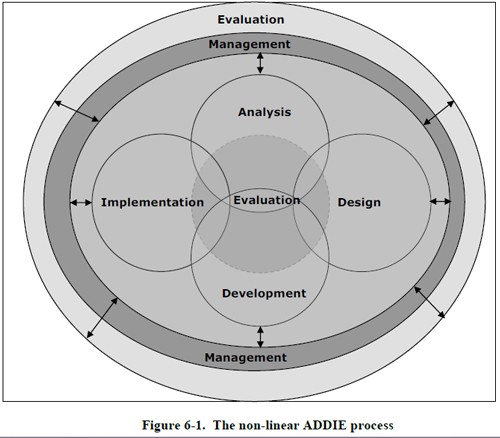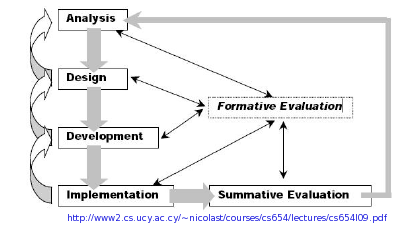ADDIE: Difference between revisions
Jump to navigation
Jump to search

m (→References) |
m (→Views) |
||
| (10 intermediate revisions by 4 users not shown) | |||
| Line 16: | Line 16: | ||
* Defition of the audience | * Defition of the audience | ||
* Tasks and needs analysis | * What is the problem? | ||
* Tasks and [[Learning needs]] analysis | |||
* Identification of constraints | * Identification of constraints | ||
* ... | * ... | ||
| Line 45: | Line 46: | ||
== Views == | == Views == | ||
ADDIE | ADDIE could be viewed both as a component and a phase model as shown by the Nicolas Tsapatsoulis' drawing. Addie, when created around 1975 was first a waterfall model and then gradually evolved into a more dynamic one. | ||
[[Image: Addie-flow-chart.png]] | [[Image: Addie-flow-chart.png]] | ||
In more recent times, the US army interprets ADDIE as a non-linear model. | |||
[[Image: ADDIE-non-linear-clark.png|frame|none|Clark, D.R. (2004). Why Instructional System Design and ADDIE? Retrieved from | |||
http://www.nwlink.com/~donclark/hrd/sat1.html on nov 10 2016]] | |||
== Links == | == Links == | ||
| Line 58: | Line 62: | ||
* http://www.intulogy.com/addie/ADDIE-Flowchart-by-Intulogy.pdf A nice ADDIE Flowchart. | * http://www.intulogy.com/addie/ADDIE-Flowchart-by-Intulogy.pdf A nice ADDIE Flowchart. | ||
* http://www2.cs.ucy.ac.cy/~nicolast/courses/cs654/lectures/cs654l09.pdf Nicolas Tsapatsoulis lecture notes (retrieved 18:30, 19 May 2006 (MEST)) | * http://www2.cs.ucy.ac.cy/~nicolast/courses/cs654/lectures/cs654l09.pdf Nicolas Tsapatsoulis lecture notes (retrieved 18:30, 19 May 2006 (MEST)) | ||
* A definition of the [http://www.learning-theories.com/addie-model.html ADDIE Model]. | |||
== References == | == References == | ||
* Donald Clark (2000), Introduction to Instructional System Design, [http://www.nwlink.com/~donclark/hrd/sat.html web site]. Recommended on-line introductory handbook. | * Donald Clark (2000), Introduction to Instructional System Design, [http://www.nwlink.com/~donclark/hrd/sat.html web site]. Recommended on-line introductory handbook. | ||
* Bentley, Joanne (2005, October 10). OER IID - Intro to Instructional Design, Spring 2005, Lecture Notes. Retrieved August 06, 2009, from Free Online Course Materials — USU OpenCourseWare Web site: http://ocw.usu.edu/Other_Educational_Resources/Intro_to_Instructional_Design/resource94.html. | |||
* van Merriënboer, J.J.G. (1997). Training Complex Cognitive Skills: A Four-Component Instructional Design Model for Technical Training. Englewood Cliffs, New Jersey: Educational Technology Publications. | |||
* U.S. Department of Defense (1975). Interservice Procedures for Instructional Systems Development Model. TRDOC Pamphlet 350-30. August, 1975. http://files.eric.ed.gov/fulltext/ED164745.pdf. This is one of the first texts on ISD. The ADDIE model is presented on page 26ff, however the "Evaluation" is called "Control", i.e. that would make it "ADDIC" | |||
[[Category:Design methodologies]] | [[Category:Design methodologies]] | ||
[[Category:Instructional design methods]] | [[Category:Instructional design methods]] | ||
Latest revision as of 18:02, 10 November 2016
Definition
- ADDIE is a Instructional design method, more particularly a Instructional systems design model
- ADDIE = Analysis, Design, Development, Implementation, Evaluation"
- ADDIE = Analyze, Design, Develop, Implement, Evaluate"
Components
Although one may call a component a phase, the five components of ADDIE are not necessarily linear, you may have to come back to any one at any given time.
Analysis Phase
- Defition of the audience
- What is the problem?
- Tasks and Learning needs analysis
- Identification of constraints
- ...
Design Phase
- Analyse subject matter in depth
- Identify objective, i.e. competencies (skills, knowledge, attitudes, etc.) to be achieved. See learning types.
- Identify a sequence to meet these objectives
- Create learning scenarios for each subject objective
- Identify kinds of learning materials and tools needed
Development Phase
- do it :)
Implementation Phase
- use it
- You may have to train both teachers and learners
- Insure delivery, e.g. through an LMS, a book, CD Rom,
Evaluation Phase
- Evaluate the design. See Design methodology.
- Build measurement tools, monitor implementation, and evaluate measurements to baseline. This phase is performed throughout the entire process.
Views
ADDIE could be viewed both as a component and a phase model as shown by the Nicolas Tsapatsoulis' drawing. Addie, when created around 1975 was first a waterfall model and then gradually evolved into a more dynamic one.
In more recent times, the US army interprets ADDIE as a non-linear model.

Clark, D.R. (2004). Why Instructional System Design and ADDIE? Retrieved from http://www.nwlink.com/~donclark/hrd/sat1.html on nov 10 2016
Links
- http://ed.isu.edu/addie/ (nice "how to" summary, commented pointers to other sites)
- http://www.nwlink.com/~donclark/perform/process.html
- http://fog.ccsf.cc.ca.us/~mmalacho/OnLine/ADDIE.html
- http://www.intulogy.com/addie/index.html Good introductory Handbook
- http://www.intulogy.com/addie/ADDIE-Flowchart-by-Intulogy.pdf A nice ADDIE Flowchart.
- http://www2.cs.ucy.ac.cy/~nicolast/courses/cs654/lectures/cs654l09.pdf Nicolas Tsapatsoulis lecture notes (retrieved 18:30, 19 May 2006 (MEST))
- A definition of the ADDIE Model.
References
- Donald Clark (2000), Introduction to Instructional System Design, web site. Recommended on-line introductory handbook.
- Bentley, Joanne (2005, October 10). OER IID - Intro to Instructional Design, Spring 2005, Lecture Notes. Retrieved August 06, 2009, from Free Online Course Materials — USU OpenCourseWare Web site: http://ocw.usu.edu/Other_Educational_Resources/Intro_to_Instructional_Design/resource94.html.
- van Merriënboer, J.J.G. (1997). Training Complex Cognitive Skills: A Four-Component Instructional Design Model for Technical Training. Englewood Cliffs, New Jersey: Educational Technology Publications.
- U.S. Department of Defense (1975). Interservice Procedures for Instructional Systems Development Model. TRDOC Pamphlet 350-30. August, 1975. http://files.eric.ed.gov/fulltext/ED164745.pdf. This is one of the first texts on ISD. The ADDIE model is presented on page 26ff, however the "Evaluation" is called "Control", i.e. that would make it "ADDIC"
